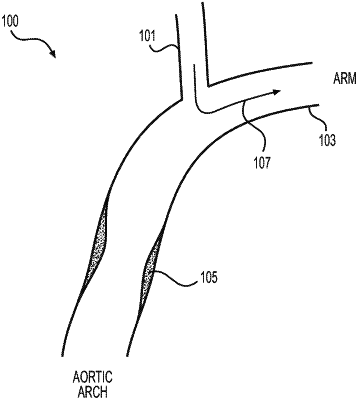| CPC A61B 5/026 (2013.01) [A61B 5/02028 (2013.01); A61B 5/7246 (2013.01); A61B 5/7275 (2013.01); A61B 5/7278 (2013.01); A61B 5/74 (2013.01); A61B 8/06 (2013.01); A61B 8/0891 (2013.01); A61B 34/10 (2016.02); G16H 50/20 (2018.01); G16H 50/50 (2018.01); A61B 5/742 (2013.01); A61B 8/488 (2013.01)] | 20 Claims |

|
1. A computer-implemented method of determining blood flow deviation in a patient's vasculature, the method comprising:
receiving a patient-specific anatomic model of at least a portion of a patient's vasculature;
modifying the patient-specific anatomic model to create a plurality of modified models, wherein each of the plurality of modified models includes a respective proposed treatment of a plurality of proposed treatments for a condition other than vascular steal syndrome;
receiving (1) a first reference blood flow magnitude indicating an amount of blood flow at a predetermined first location of a population-based reference vasculature, and (2) a second reference blood flow magnitude indicating an amount of blood flow at a predetermined second location of the population-based reference vasculature;
calculating a reference relative blood flow magnitude by comparing the first reference blood flow magnitude to the second reference blood flow magnitude;
for each modified model of the plurality of modified models:
(a) simulating, non-invasively, (1) a respective first patient-specific blood flow magnitude indicating a first amount of blood flow at a first location of the patient's vasculature corresponding to the predetermined first location of the population-based reference vasculature, and (2) a respective second patient-specific blood flow magnitude indicating a second amount of blood flow at a second location of the patient's vasculature corresponding to the predetermined first location of the population-based reference vasculature;
(b) determining a respective patient-specific relative blood flow magnitude by comparing the respective first patient-specific blood flow magnitude to the respective second patient-specific blood flow magnitude; and
(c) determining whether the respective proposed treatment induces vascular steal by determining a difference or ratio between the reference relative blood flow magnitude and the respective patient-specific relative blood flow magnitude; and
based on the determination of whether each of the respective proposed treatments induces vascular steal, providing a recommendation of at least one proposed treatment of the plurality of proposed treatments.
|